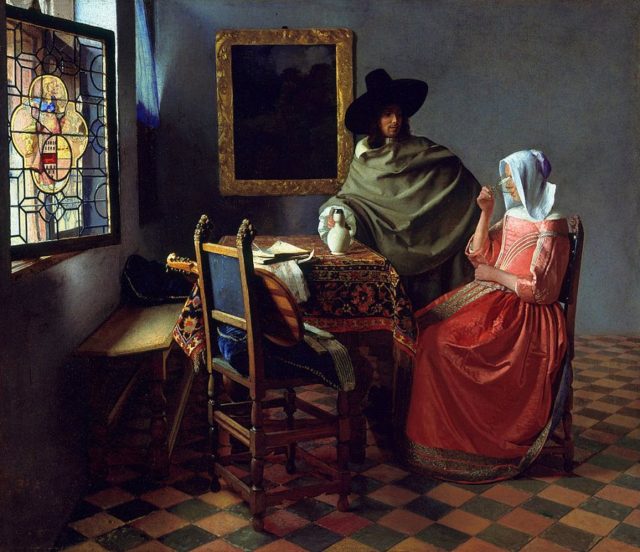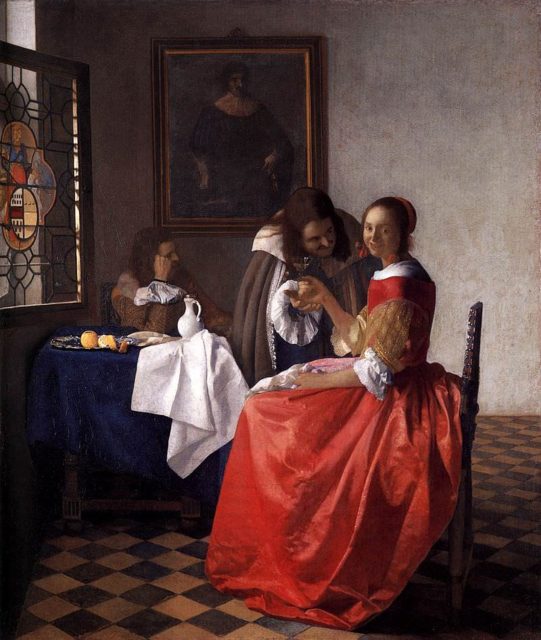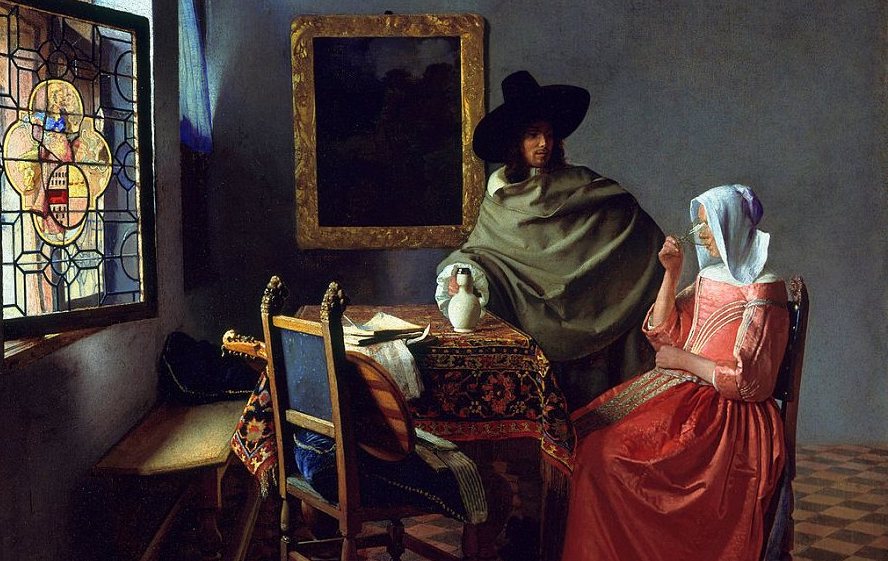Johannes Vermeer, a Golden era Dutch painter, was an artist emblematic of traditional Dutch genre paintings. His works, The Glass of Wine and The Girl with a Wine Glass are two very similar scenes that highlight societal anxieties about women and their activities “behind closed doors.” These anxieties were especially elevated when the patriarch of the house was absent, and the home was left solely to the responsibility of women. In Dutch society, women were seen as a vessel through which the Dutch Republic could explore its moral and religious ideals. Virtue and domesticity were considered to be attributes of a “good” woman, who kept her house in order, even when her husband was away. Vermeer references the societal anxiety about women engaging in immoral activities, such as entertaining strangers – soldiers in particular. The morality of the newly founded Republic was read through the actions of women, so any sexual impropriety was a sign of the failure of the Republic to firmly stand among the powers of Europe. Because of this, the burden heavily lay on the women depicted in art to not only keep her household in order, but also to project an image of herself which works in accordance with the ideals of the emerging Dutch nation. Vermeer’s The Glass of Wine demonstrates an implicit insinuation of immorality, while The Girl With a Wine Glass is an explicit statement on the sexual impropriety of the painting’s female subject.

In The Glass of Wine, a woman is depicted drinking from a glass handed to her by a man who stands beside her, waiting to pour another. The Girl with a Wine Glass shows two characters engaging with each other, who appear to be the same as in the former painting, with an additional male figure in the background. The woman, who is entertaining the original man, looks directly at the viewer. The importance of the presence of a male figurehead is depicted through the paintings that Vermeer chooses to hang in both of the rooms. The initial and implicit depiction of immorality occurs in front of a landscape, whereas the woman’s sexual impropriety is witnessed by the portrait of what the viewer can assume to be the “man of the house.” Thus, while the architectural features of the room remain the same, the background of the artworks give new meaning and consequences to the actions of the woman.
The burden heavily lay on the women depicted in art to not only keep her household in order, but also to project an image of herself which works in accordance with the ideals of the emerging Dutch nation.
The use of the female body for a blank canvas on which male rulers could paint their theories of morality is an idea which can still be considered in the context of today’s society; one might even argue that Vermeer’s work is a precedent for the consideration of women as peacemakers and vessels of moderation. In contrast to this, throughout the 17th century, a wide variety of literature was published by male authors depicting the common trope of a clever, evil wife out to betray her husband. Vermeer promoted this characterization of women within his artwork; the women in his paintings were either portrayed as well-behaved, domestic caretakers, or as malevolent, deceitful beacons of impropriety. In the case of The Girl with a Wine Glass, the woman is entertaining strangers and bringing the outside world into what is seen as her husband’s domain, signifying that once he leaves the house, he has no power and is thus emasculated by her.

Vermeer uses the glass in the two different paintings to demonstrate her deteriorating morality, as she is depicted as holding it in two different ways. In The Glass of Wine, the woman is holding the glass in a way which would imply she is of a higher social class. In The Girl with a Wine Glass, the woman is holding the glass with her fingers splayed, in a way that is indicative of lower class. Because of this, the interior of the household is changed from a domestic scene to one resembling a brothel. These small details also subconsciously promote classist and misogynistic undertones, implying that lower-class women are inherently immoral in the eyes of Dutch society.
Vermeer uses the jug to symbolize the supposed immoral action that the female figure is about to pursue, employing it in a way that starkly contrasts with its traditional use as an object symbolizing female domesticity. It is a clear act of defiance against the moral code of 17th-century Dutch society, one that permitted men to engage in sexual activity, while shaming women for the same. When we consider the effects of this act of adultery, the man will likely not face as serious societal repercussions. The jug also carries alcohol instead of water or milk, highlighting the fact that the domestic household is being turned into a site of immorality.
As women became symbols of the state’s agenda rather than people, their agency, even in the domestic space, was limited, and their morality and humanity was reduced to their perceived relationships with men.
These artworks show a rather interesting view of morality centred around the woman figure in the two paintings. Her abandonment of domestic chores and embracing of sexuality is symbolic of what was thought at the time to occur if women were left alone in the domestic space. With the recent establishment of the Dutch Republic, the domestic space could not afford such unpredictability. Thus, female subjects within artwork, much like the women of the Republic themselves, became synonymous with the country as a whole. As women became symbols of the state’s agenda rather than people, their agency, even in the domestic space, was limited, and their morality and humanity was reduced to their perceived relationships with men.

